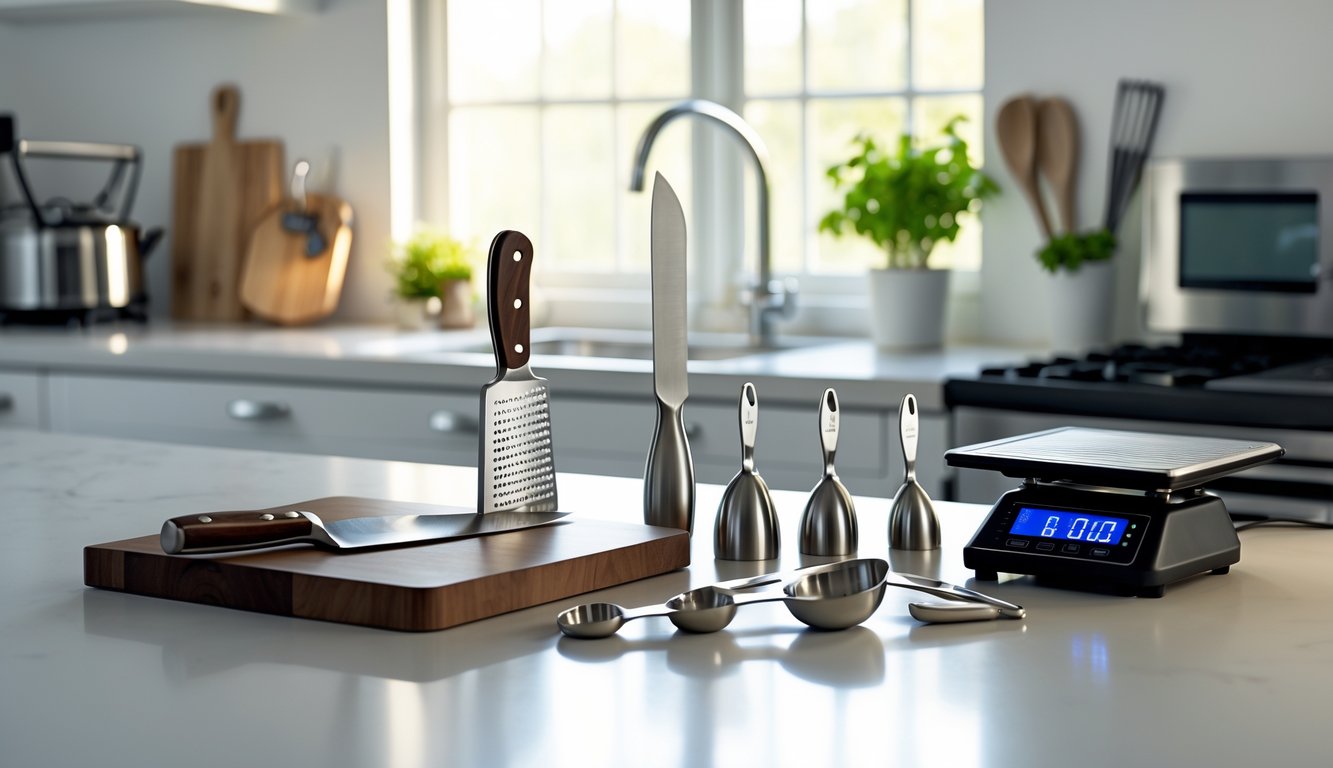
Alright, so last Thursday I dug out my old chef’s knife—the ugly, beat-up one, not that overpriced “Damascus” thing influencers love—and it just glided through shallots like it had something to prove. Meanwhile, my new garlic press? Snapped in half. Useless. I’m convinced the kitchen tools that actually matter aren’t the shiny ones. It’s always the eight-inch Japanese knife, those tongs with the weird scorch mark, or the nonstick spatula everyone pretends not to use but somehow ends up in every single pan. Honestly, I trust Dan (ex-line cook, now just a guy who yells at me about storage containers) way more than any magazine’s “must-have” list. He claims only three tools survive a dinner rush, and I believe him.
I’m not gonna pretend I follow Michelin-level advice, but the real secret? It’s never Bluetooth gadgets or titanium whatevers. It’s always a Shun knife, some ancient heatproof bowl, a dough scraper that looks like it’s been through a war. Recipe blogs barely mention this stuff. (Sidebar: Even actual chefs swear by these “basic” tools.) Oh, and somewhere in my mess of a drawer, I’ve got a thermometer with flour crusted on it. Not glamorous, just proof I survived brunch service once or twice.
Egg separators, piping bags, peelers so sharp they scare me—everyone hypes them, but at home? They vanish. Pros treat them like gold, but mine wander into the junk drawer. And why does every kitchen injury start with a dull knife? If some YouTube chef starts raving about a blender, just remember: the real pros already picked their favorites and they’re probably on this list, not in a late-night infomercial.
The Everyday Tools of Culinary Professionals
Grocery store knives? They look sharp until you try to speed-slice a tomato and end up with a crime scene. I overthink spatulas—offset or not—because every bargain bin one bends and then I’m chasing burnt bits around a hot pan, thinking about the Mercer Culinary offset spatula that’s somehow legendary in pro kitchens, but nobody outside seems to know about. Most restaurant kitchens I’ve seen? Minimalist. If it doesn’t earn its keep, it’s gone.
Chefs’ Top Must-Have Utensils
Walk into any real kitchen, not the staged ones, and there’s always a Microplane zester next to tongs that look like they’ve been run over. Editors at Food & Wine say chefs are picky about brands like Mercer and Vitamix, but try to take a wooden spoon away from a line cook. Just try. You’ll lose a finger. Home cooks miss out on how much better a razor-sharp Japanese gyuto or high-carbon paring knife feels. Those “pro-grade” gadgets from TV? Not even close.
Speed’s everything. Offset spatulas for leveling cakes, heavy fish spatulas for, well, everything but fish, and tongs—restaurants go through them like napkins. Multitools? Never last. It’s always the basic, tough single-use stuff that wins. Even pro chef lists barely scratch the surface. Garlic presses? Nope. Avocado slicers? Please.
Why Quality Tools Matter in a Busy Kitchen
The day a cheap saucepan warped and dumped sauce all over my shoes, I learned my lesson. My old chef used to yell, “Buy it once or buy it twice!” and honestly, he wasn’t wrong. I’ve watched cooks run a Vitamix for hours—no problem. The bargain blender? Dead in a shift.
It’s not snobbery, it’s survival. Every square inch in a restaurant kitchen costs real money. CNET’s chef advice backs this up—don’t waste space on stuff that slows you down. Even maintenance (sharpening stones, mineral oil for boards) turns cheap tools into a headache.
The weirdest part? The perfect peeler or offset spatula always disappears. Nobody wants to borrow my kitchen scale, though. Maybe people just like chaos. Or they’re hoping for a little kitchen drama.
The Role of a General Contractor in Kitchen Efficiency
Nobody talks about the general contractor, but wow, does it matter. You don’t care about sink angles until you try chopping cilantro for an hour and the table’s too low. I helped open a café once. The dish pit was off by half an inch. We needed an extra person just to keep up. That’s a payroll disaster.
Great contractors actually listen to chefs, which is rare. They’ll move outlets, tweak ventilation (never enough, ever), and make sure the fridge opens the right way. I never realized how a couple inches here or there could save so much time.
Honestly, people throw money at gadgets instead of fixing basic layout problems. Chefs hoard tools at their stations, backup knives jam drawers, and the line grinds to a halt when the pass is too narrow. Sometimes I think “built to code” just means “don’t blame me when the chef screams.”
Essential Knives Every Pro Depends On
You start with a drawer full of junk knives from old roommates, but pros keep it tight—just the essentials. Three knives, tops. That’s not an accident. Every demo, every prep line, it’s the same. No flash, just what actually works. Picking up the right blade mid-chaos? That’s everything.
Chef’s Knife: The Workhorse
I grab my 8-inch chef’s knife for almost everything, even when I swear I’ll use something else. Old habits. It hacks through squash, minces herbs, fakes a brunoise on a wobbly board. Food Network chefs beg for their own knives on set. Kitchens budget $100 or more per knife, Epicurious says so. The right weight, a curved edge, a handle that actually fits—makes all the difference. Salad prep is a breeze, chicken breakdown doesn’t shred your hands.
But if the balance is off? My hand cramps. Cheap plastic handles? They get gross, slippery, sometimes just vanish. My old sous chef always said, “Leave the cleaver for stock.” This one knife does it all. If it’s in the dishwasher, I panic.